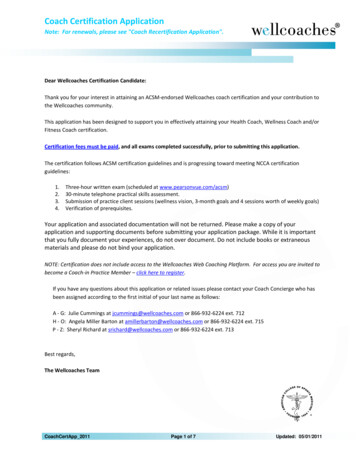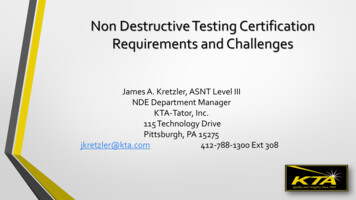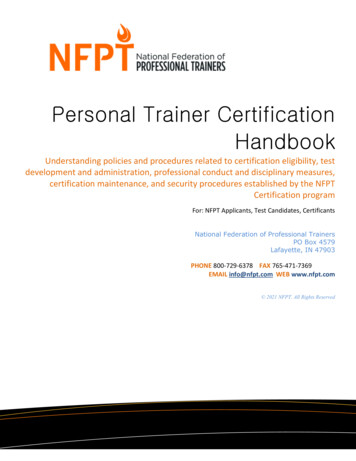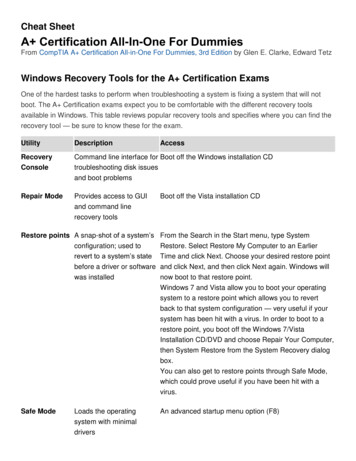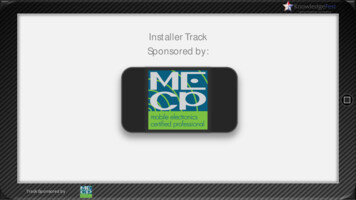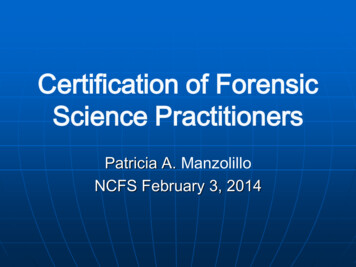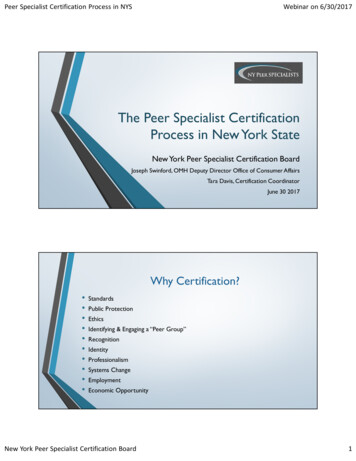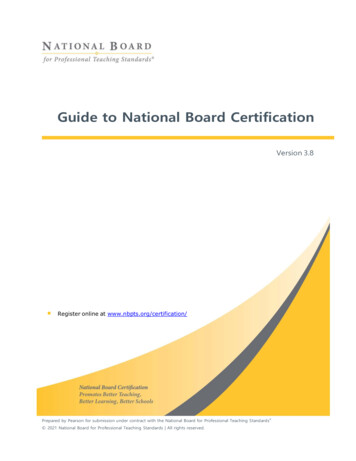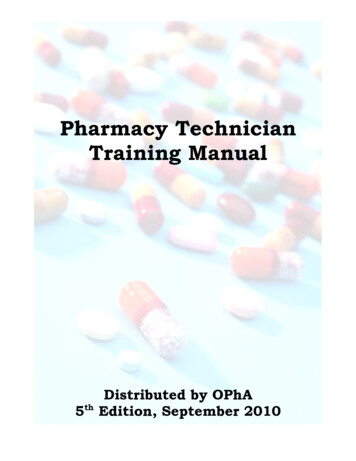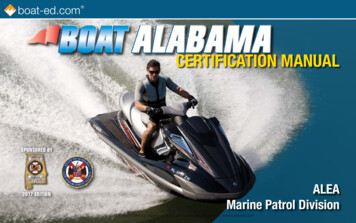
Transcription
CERTIFICATION MANUALSPONSORED BY 2017 EDITIONAL3717ZWALEAMarine Patrol DivisionCopyright 2017 Kalkomey Enterprises, LLC and its divisions and partners, www.kalkomey.com
Dear Alabama Boater:The Roberson/Archer Act passed by the Alabama Legislature in 1994 requires boater certification for all operatorsof motorized vessels. The Act was named in memory of three Alabama children—Lauren Archer, age 4, and Katey andAshleigh Roberson, ages 5 and 9, who were tragically killed in boating accidents in 1993. Their deaths and a crusadeby their families led to the passage of the Act, which has been widely acclaimed as a national model for boating safetylaw.This manual is designed to assist you in achieving two primary objectives: (1) to help you qualify for Alabama boatoperator’s certification and (2) to help you become a better informed and safer operator. The information containedin this manual is not intended to be an official legal reference for all boating laws and regulations. It is intended toexplain in common language those laws, regulations, and boating practices you will need most often. In addition, theprocedure for obtaining your boat operator’s certification is discussed.Marine Patrol troopers patrol our waterways to make your boating experience safe and pleasant. Cooperate with themwhile operating your boat by following the suggestions outlined in this manual as well as the rules of common courtesy.Sincerely,Major Walter S. Thompson, ChiefMarine Patrol DivisionCopyright 2017 Kalkomey Enterprises, LLC and its divisions and partners, www.kalkomey.com
CERTIFICATION MANUALSponsored byALEA Marine Patrol DivisionP.O. Box 304115Montgomery, AL 36130334-517-2950Major Walter S. Thompson, ChiefPublished by Boat Ed , a division of Kalkomey Enterprises, LLC, 14086 Proton Road, Dallas, TX 75244, 214-351-0461. Printed in the U.S.A.Copyright 2003–2017 by Kalkomey Enterprises, LLC. All rights reserved. No part of this publication may be reproduced in any form or by any process without permission in writing from KalkomeyEnterprises, LLC. Effort has been made to make this publication as complete and accurate as possible. All references contained in this publication have been compiled from sources believed to be reliable,and to represent the best current opinion on the subject. Kalkomey Enterprises, LLC is not responsible or liable for any claims, liabilities, damages, or other adverse effects or consequences to any person orproperty caused or alleged to be caused directly or indirectly from the application or use of the information contained in this publication. P0515www.kalkomey.comThe ALEA Marine Patrol Division does not discriminate on the basis of race, color, religion, age, gender, national origin, or disability in its hiring or employment practices nor in admission to, access to, oroperation of its programs, services, or activities.Copyright 2017 Kalkomey Enterprises, LLC and its divisions and partners, www.kalkomey.com
How to Use This ManualEvery person who operates a motorized vessel on Alabama’s waterways must have obtained Alabama boater safety certification. You may obtainAlabama boater safety certification by showing valid proof of passing an approved boating safety course (see page 14) or by passing a certificationexam given by the Alabama Department of Public Safety Driver’s License Division. This manual is designed to prepare you to take the certification exam given by the Alabama Department of Public Safety Driver’s License Division.Take the Department of Public Safety Driver’sLicense Division Certification ExamIf you choose to obtain your Alabama boater safety certification bytaking the exam given by the Alabama Department of Public SafetyDriver’s License Division, you should:1. Study this manual to prepare for the exam.2. Go to the Department of Public Safety Driver’s LicenseExamining Office in your county of residence to take the25-question exam. You will be required to present personalidentification.3. Upon passing (answering 20 of the 25 questions correctly), applyfor your Alabama boater safety certification. You will have the“V” class placed on your automobile driver’s license. Or, if youdo not have an automobile driver’s license, you will be issued a“Vessel Only” license.Or Take the Online Course and Certification ExamYou can take an approved boating safety course online atwww.boat-ed.com/alabama.After passing the online exam, you will be mailed a course certificate fromthe ALEA Marine Patrol. Take this certificate and personal identificationto the Department of Public Safety Driver’s License Examining Office inyour county of residence to have the “V” class placed on your automobiledriver’s license. Or, if you do not have an automobile driver’s license, youwill be issued a “Vessel Only” license.Stay up to date on new boating laws!For state boating law information, call the DPS-Marine PatrolDivision at 334-517-2950 or visit www.alea.gov.For federal boating laws, visit the U.S. Coast Guard’s boating safetywebsite at: www.uscgboating.org.Information in this manual does not replace what is specifically legal for boating inAlabama, which is found in Alabama Code and federal laws.Copyright 2017 Kalkomey Enterprises, LLC and its divisions and partners, www.kalkomey.com
1Table of ContentsBOATINGBefore Going OutVessel Length Classes . . . . . . . . . . . . . . . 2Vessel Capacity . . . . . . . . . . . . . . . . . . . . 2Fueling a Vessel . . . . . . . . . . . . . . . . . . . . 2Additional Safety Proceduresfor PWCs . . . . . . . . . . . . . . . . . . . . . 3Filing a Float Plan . . . . . . . . . . . . . . . . . . 3Pre-Departure Checklist . . . . . . . . . . . . . 3On the WaterEncountering Other Vessels . . . . . . . . . . 4Encountering Vessels With LimitedManeuverability . . . . . . . . . . . . . . . . 4Navigation Rules . . . . . . . . . . . . . . . . . . 4Nighttime Navigation . . . . . . . . . . . . . . . 5Encountering Vessels at Night . . . . . . 6Encountering a Sailboat at Night . . . . 6U.S. Aids to Navigation System . . . . . . . 6Lateral Markers . . . . . . . . . . . . . . . . . . 6Non-Lateral Markers . . . . . . . . . . . . . 8IT'S THEWeather Emergencies . . . . . . . . . . . . . . . 9VHF Channels forRecreational Boaters . . . . . . . . . . . . . 9What to Do if Caughtin Foul Weather . . . . . . . . . . . . . . . . 9Other Boating Emergencies . . . . . . . . . 10Falling Overboard . . . . . . . . . . . . . . . 10Capsizing or Swamping . . . . . . . . . . 10Hypothermia . . . . . . . . . . . . . . . . . . 10Carbon Monoxide Poisoning . . . . . . 11Preventing Theft . . . . . . . . . . . . . . . . . . 11Boater Safety CertificationAge and Boater CertificationRequirements for Operators . . . . . . . . 12How to Obtain Boater Certification . . . 14Other Facts About Boater Certification 15Required EquipmentPersonal Flotation Devices . . . . . . . . . . 16Fire Extinguishers . . . . . . . . . . . . . . . . . 17Navigation Lights . . . . . . . . . . . . . . . . . 18Ventilation Systems . . . . . . . . . . . . . . . . 19Backfire Flame Arrestors . . . . . . . . . . . . 19Mufflers and Noise Level Limits . . . . . . 20Sound-Producing Devices . . . . . . . . . . . 20Other Equipment . . . . . . . . . . . . . . . . . 21Copyright 2017 Kalkomey Enterprises, LLC and its divisions and partners, www.kalkomey.comOn the WaterUnlawful and Dangerous Operation . . . 22Obstructing Navigation . . . . . . . . . . . . 23Homeland Security Restrictions . . . . . . 23Enforcement . . . . . . . . . . . . . . . . . . . . . 23Boating Accidents . . . . . . . . . . . . . . . . . 24Alcohol and Drugs . . . . . . . . . . . . . . . . 24Disposal of Trash, Garbage,or Plastics . . . . . . . . . . . . . . . . . . . . . . 25Specifically for PWCsLegal Requirements Specificto PWCs . . . . . . . . . . . . . . . . . . . . . . . 26Specifically for SkiingLegal Requirements forTowing Skiers . . . . . . . . . . . . . . . . . . . 27
Before Going Out A vessel’s length class dictates the equipmentnecessary to comply with federal and state laws.Vessels are divided into four length classes: Less than 16 feet 16 feet to less than 26 feet 26 feet to less than 40 feet 40 feet to less than 65 feetLength is measured from the tip of the bow in astraight line to the stern. This does not includeoutboard motors, brackets, rudders, bow attachments, or swim platforms and ladders that are nota molded part of the hull.Vessel Capacity Personal watercraft (PWCs) and some other vessels do not havea capacity plate. Always follow the recommended capacity in theowner’s manual and on the manufacturer’s warning decal.Fueling a VesselLengthVessel Length ClassesInboardsOutboardsLengthBefore going out on the water, take steps tomake the outing safe and enjoyable. Always check the capacity plate usually foundnear the operator’s position or on the vessel’s transom.This plate indicates the maximum weight capacity andmaximum number of people that the vessel can carry safely.Never fuel at night unless it is an emergency. If you must refuel afterdark, use only electric lights. Try to refuel away from the water or on acommercial fueling ramp. Before beginning to fuel: Dock the boat securely and ask all passengers to exit. Do not allow anyone to smoke or strike a match. Check all fuel lines, connections, and fuel vents. Turn off anything that might cause a spark—engines, fans, orelectrical equipment. Shut off all fuel valves and extinguish all open flames, such asgalley stoves and pilot lights. Close all windows, ports, doors, and other openings to preventfumes from entering the boat. Remove portable fuel tanks and fill them on the dock.The most important safe fueling practice If your vessel is equipped with a power ventilation system,turn it on for at least four minutes after fueling and beforestarting your engine to remove gas vapors.Copyright 2017 Kalkomey Enterprises, LLC and its divisions and partners, www.kalkomey.com
Boating Basics 3 While filling the fuel tank: Keep the nozzle of the fuel-pump hose in contact with the tankopening to prevent producing a static spark. Avoid spilling fuel into the boat’s bilge or the water. Never fill a tank to the brim—leave room for gas to expand.After fueling: Wipe up any spilled fuel. Open all windows, ports, doors, and other openings.Additional Safety Procedures for PWCs Do not tip the PWC in order to fill it all the way up. If the tank isoverfilled, the fuel may expand and spill into the water.After fueling, open the door of the engine compartment and sniffto check for any evidence of gas fumes. Do this before starting theengine. If you do smell gas fumes, determine the source and makerepairs immediately.Filing a Float PlanBefore going out on a vessel, it is always a good idea to leave a floatplan with a relative or friend, or at least with a local marina. A floatplan should: Describe the vessel, including its registration number, length, make,horsepower, and engine type. State where you are going, the detailed route, your planneddeparture time, and your expected return time. Give the name, address, and telephone number of each person onboard and an emergency contact.Pre-Departure ChecklistYou can help assure a good time while operating your vesselby performing this pre-departure check. Check the weather forecast for the area and timeframeduring which you will be boating. Make sure that the steering and throttle controls operateproperly and all lights are working properly. Check for any fuel leaks from the tank, fuel lines, andcarburetor. Check the engine compartment for oil leaks. Check hose connections for leaks or cracks, and make surehose clamps are tight. Drain all water from the engine compartment, and be surethe bilge plug is replaced and secure. Check to be sure you have a fully charged engine batteryand fire extinguishers. If so equipped, make sure the engine cut-off switch andwrist lanyard are in good order. Make sure you have the required number of PFDs andcheck that they are in good condition. Leave a float plan with a reliable friend or relative.Copyright 2017 Kalkomey Enterprises, LLC and its divisions and partners, www.kalkomey.com
On the WaterSafe navigation on Alabama waterways is everyone’s responsibility. Allvessel operators are equally responsible for taking action necessary toavoid collisions. Encountering Other VesselsEven though no vessel has the “right-of-way” over another vessel, thereare some rules that every operator should follow when encounteringother vessels. It is the responsibility of both operators to take the actionneeded to avoid a collision. The following shows what to do whenencountering another vessel.To prevent collisions, every operator shouldfollow the three basic rules of navigation. Practice good seamanship. Keep a sharp lookout. Maintain a safe speed and distance. A vessel engaged in commercial fishing A sailboat under sail unless it is overtakingWhen operating a vessel under sail, you must give way to: Any vessel not under command Any vessel restricted in its ability to maneuver A vessel engaged in commercial fishingNavigation RulesThere are two terms that help explain these rules.Stand-on vessel: The vessel which should maintain itscourse and speed Give-way vessel: The vessel which must take early and substantialaction to avoid collision by stopping, slowing down, or changingcourse Meeting Head-OnEncountering Vessels With Limited Maneuverability When operating a power-driven vessel, you must give way to: Any vessel not under command, such as an anchored or disabledvessel Any vessel restricted in its ability to maneuver, such as a vesseltowing or laying cable, or a vessel constrained by its draft, such asa large ship in a channelGiveway!Giveway!Power vs. PowerPower vs. Power: Neithervessel is the stand-on vessel.Both vessels should keep tothe starboard (right).Power vs. Sail: Thepowerboat is the give-wayvessel. The sailboat is thestand-on vessel.Copyright 2017 Kalkomey Enterprises, LLC and its divisions and partners, www.kalkomey.comGiveway!Power vs. Sail
Boating Basics 5Crossing SituationsPower vs. Power: The vesselon the operator’s port (left)side is the give-way vessel.The vessel on the operator’sGive starboard (right) side is theway! stand-on vessel.Power vs. Sail: Thepowerboat is the give-wayvessel. The sailboat is thePower vs. Powerstand-on vessel. Giveway! Power vs. Sail OvertakingPower vs. Power: The vesselthat is overtaking anothervessel is the give-way vessel.The vessel being overtakenis the stand-on vessel.Power vs. Sail: The vesselGive that is overtaking anotherway! vessel is the give-way vessel.The vessel being overtakenPower vs. Power is the stand-on vessel.Nighttime NavigationGiveway!Power vs. SailBe on the lookout for the lights of other vessels when boating at night.Several types of lights serve as navigational aids at night. There are fourcommon navigation lights. masthead lightSidelights: These red and green lightsare called sidelights (also called combi- (225 degrees)nation lights) because they are visibleto another vessel approaching from theside or head-on. The red light indicatesa vessel’s port (left) side; the greenindicates a vessel’s starboard (right) side.Sternlight: This white light is seen frombehind or nearly behind the vessel.Masthead Light: This white lightshines forward and to both sides and isrequired on all power-driven vessels. Asternlightmasthead light must be displayed by all sidelights(combination)vessels when under engine power. Theabsence of this light indicates a sailboatunder sail.all-round white lightAll-Round White Light: On power(360 degrees)driven vessels less than 39.4 feet inlength, this light may be used tocombine a masthead light and sternlight into a single white light thatcan be seen by other vessels from anydirection. This light serves as an anchorsidelightslight when sidelights are extinguished.Copyright 2017 Kalkomey Enterprises, LLC and its divisions and partners, www.kalkomey.com(combination)
Boating Basics 6Encountering Vessels at NightGive wayStand on, butbe preparedto give way!Give wayWhen you see only a white light, youare overtaking another vessel. It is thestand-on vessel whether it is underwayor anchored. You may go around it oneither side.Encountering aSailboat at NightWhen you see only a red lightor only a green light, you areapproaching a sailboat under sailand you must give way. The sailboatunder sail is always the stand-onvessel!Give wayGive wayWhen you see a green and a whitelight, you are the stand-on vessel.However, remain alert in case theother vessel operator does not see youor does not know the navigation rules.U.S. Aids to Navigation System (ATON)When you see a red and a white light,you must give way to the other vessel!Slow down and allow the vessel topass, or you may turn to the right andpass behind the other vessel.Lateral MarkersBuoys and markers are the “traffic signals” that guide vesseloperators safely along some waterways. They also identifydangerous or controlled areas and give directions and information.As a recreational boat or PWC operator, you will need to know thelateral navigation markers and non-lateral markers of the U.S. Aidsto Navigation System.These navigation aids are used to mark the edges of safe water areas; forexample, directing travel within a channel. The markers use a combination of colors and numbers, which may appear on either buoys orpermanently placed markers.Copyright 2017 Kalkomey Enterprises, LLC and its divisions and partners, www.kalkomey.com
Boating Basics 7Red colors, red lights, and even numbers indicatethe right side of the channel as a boater enters fromthe open sea or heads upstream.Green colors, green lights, and odd numbersindicate the left side of the channel as a boater entersfrom the open sea or heads upstream.Red and green colors and/or lights indicate thepreferred (primary) channel. If green is on top, thepreferred channel is to the right as a boater entersfrom the open sea or heads upstream; if red is on top,the preferred channel is to the left.Lighted Buoys use the lateral marker colors andnumbers discussed above; in addition, they have amatching colored light.Daymarks are permanently placed signsattached to structures, such as posts, in thewater. Common daymarks are red triangles(equivalent to nuns) andgreen squares (equivalent to cans).They may be lighted also.open watersopen watersNuns are red cone-shaped buoys marked witheven numbers.Cans are green cylindrical-shapedbuoys marked with odd numbers.Red Right Returning is a reminder of the correct course whenreturning from open waters or heading upstream.Copyright 2017 Kalkomey Enterprises, LLC and its divisions and partners, www.kalkomey.com
Boating Basics 8Non-Lateral MarkersNon-lateral markers are navigational aids that give information abouttopics other than the edges of safe water areas. The most common areregulatory markers, as shown below, that are white and use orangemarkings and black lettering. These markers are found on lakes andrivers.InformationSquares indicatewhere to find food,supplies, repairs,etc. and give directions and otherinformation.ControlledCircles indicate acontrolled area suchas speed limit, nofishing or anchoring,ski only or no skiing,or “slow, no wake.”ExclusionCrossed diamondsindicate areas offlimits to all vesselssuch as swimmingareas, dams, andspillways.DangerDiamonds warnof dangers suchas rocks, shoals,construction, dams,or stumps. Alwaysproceed withcaution.Other Non-Lateral MarkersSafe Water Markers are whitewith red vertical stripes andmark mid-channels or fairways.They may be passed on eitherside.Inland Waters Obstruction Markers arewhite with black vertical stripes and indicatean obstruction to navigation. You shouldnot pass between these buoys and the nearestshore.Mooring BuoyAnother kind of buoy you mayencounter is the mooring buoy.These are white with a bluehorizontal band. They are usuallyplaced in marinas and other areaswhere vessels are allowed to anchor.Copyright 2017 Kalkomey Enterprises, LLC and its divisions and partners, www.kalkomey.com
Boating Basics 9Weather EmergenciesWhat to Do if Caught in Foul WeatherWeather can change very rapidly and create unexpectedsituations for vessel operators. Even meteorologists have troublepredicting rapid weather changes. You should always monitor weatherdevelopments. One way is to tune a VHF radio to the frequencieslisted below. VHF Frequencies Broadcasting NOAA Weather Reports 162.400 MHz162.425 MHz162.450 MHz162.475 MHz162.500 MHz162.525 MHz162.550 MHz VHF Channels for Recreational Boaters6 .Intership safety communications only9 .Communications between vessels (commercialand recreational), and ship to coast13 .Navigational use by commercial, military, andrecreational vessels at bridges, locks, and harbors16 .Distress and safety calls to U.S. Coast Guardand others, and to initiate calls to other vessels22 .U.S. Coast Guard broadcasts of severe weatherwarnings, hazards to navigation, and othersafety warnings24–28 .Public telephone calls (to marine operator)68, 69, 71 .Recreational vessel radio channels and shipto coast Be sure your personal flotation device (life jacket) is properlysecured on your body.If there is fog, sound your fog horn.Head for the nearest shore that is safe to approach.Head the bow into the waves at a 45-degree angle. PWCs shouldhead into the waves at a 90-degree angle.Reduce speed.Seat passengers on the bottom of the vessel, as close to the centerline as possible.Minimize the danger of having your vessel struck bylightning by seeking shelter in advance of a storm. If caughton open water during a thunderstorm, stay low in the middleof the vessel.Secure loose items. Have emergency gear ready.Keep the bilge free of water.If the engine stops, drop a “sea anchor” on a line off the bow tokeep the bow headed into the wind and reduce drifting while youride out the storm. In an emergency, a bucket will work as a seaanchor.Copyright 2017 Kalkomey Enterprises, LLC and its divisions and partners, www.kalkomey.com
Boating Basics 10Other Boating Emergencies A safe boater knows how to prevent and respond to other boatingemergencies.Falling Overboard To prevent persons from falling overboard: Don’t sit on the gunwale, bow, seat backs, motor cover, or anyother area not designed for seating. Don’t sit on pedestal seats when underway at greater than idlespeed. Don’t stand up in or lean out from the boat. Don’t move about the boat when underway.If someone on your boat falls overboard: Reduce speed and toss the victim a throwable PFD. Turn your boat around and slowly pull alongside the victim,approaching the victim from downwind or into the current,whichever is stronger. Turn off the engine. Pull the victim on board over the stern,keeping the weight in the boat balanced.Capsizing or Swamping To reduce the risk of capsizing or swamping: Don’t overload your boat. Balance the load. Slow your boat appropriately when turning. Secure the anchor line to the bow, never to the stern. Don’t boat in rough water or in bad weather. If you capsize or swamp your boat, or if you have fallenoverboard and can’t get back in: Stay with the boat. Try to reboard or climb onto it in order to get as much of yourbody out of the cold water as possible.If the boat sinks or floats away, don’t panic. If wearing a PFD, remain calm and await help. If you aren’t wearing a PFD, look around for one or for otherbuoyant items to use as a flotation device. In cold water, float rather than tread.Hypothermia If you are boating in cold water: Dress in several layers of clothing under your PFD or wear awetsuit or drysuit. Learn to recognize the symptoms of hypothermia. Symptomsbegin with shivering and bluish lips and nails, and progress to acoma and, ultimately, death.To reduce the effects of hypothermia: Put on a PFD if not wearing one. It helps you to float withoutexcessive movement and insulates your body. Get as much of your body out of the water as possible. Don’t take your clothes off unless necessary—clothes can help youfloat and provide insulation. Don’t thrash or move about. Excess motion consumes energy andincreases loss of body heat.Copyright 2017 Kalkomey Enterprises, LLC and its divisions and partners, www.kalkomey.com
Boating Basics 11 Draw your knees to your chest and your armsto your sides, protecting the major areas of heatloss. If others are in the water with you, huddletogether with your arms around their shoulders.Carbon Monoxide PoisoningCarbon monoxide is an invisible, odorless, tasteless gas that can bedeadly. To prevent carbon monoxide poisoning, keep air flowingthrough the boat and take extreme caution when running a generatorat a dock or at anchor. Whenever people are using a swim platform or are in the waterclose to the stern, turn off all gasoline-powered generators withtransom exhaust ports. Swimmers should never enter the cavity between the swim platformand the stern of the boat. When boating, becareful runningdownwind asexhaust gases mayblow back on board.On cabin cruisers,be aware thatexhaust gases canblow back into thestern when traveling into the wind.Preventing TheftDefend against theft of your vessel and equipment.Store your vessel so that it is not easily accessed. Store your vessel and trailer in a locked garage or storage area. Park another vehicle in front of the trailer, or lock the trailer to afixed object in a well-lighted area. Secure the vessel and trailer to a fixed object with a good qualitychain and lock. If moored, secure the vessel to the dock with asteel cable and lock. Remove a trailer wheel if parked for an extended time. Purchase a quality trailer hitch lock and use it. Chain and lock the motor and fuel tanks to the vessel. Mark or engrave all equipment with an identifier such as yourdriver’s license number. Photograph or videotape the interior and exterior of yourvessel, showing all installed equipment and additional gear andequipment. Make a complete inventory of your equipment, vessel,and trailer. Remove expensive electronics or other valuables if the vessel is leftunattended. Cover your vessel and always remove the keys. Title and register your vessel. Copyright 2017 Kalkomey Enterprises, LLC and its divisions and partners, www.kalkomey.com
Boater Safety CertificationAge and Boater CertificationRequirements for OperatorsThe Roberson/Archer Act of 1994 requires that every person whooperates a motorized vessel (including PWCs) on the waters ofAlabama must first obtain an Alabama boater safety certification. Thisrequirement does not apply to operators of sailboats, rowboats, orcanoes. Certification Requirements for Residents of Other States Age to Operate Legally on Alabama Waters No one under the age of 12 years may operate any motorized vessel(including PWCs) under any circumstances.Persons under the age of 12 years are not eligible for Alabamaboater safety certification.Certification Requirements for Alabama Residents If you are under 12 years of age: You may not obtain yourAlabama boater safety certification, and you may not operate avessel under any circumstances.If you are 12 or 13 years of age: You may obtain your Alabamaboater safety certification. After obtaining the certification, youmay operate a vessel legally only if supervised on board by a personwho: Is at least 21 years of age and Carries a valid proof of his or her Alabama boater safety certification and Is in position to take immediate physical control of the vessel.If you are 14 years of age or older: After obtaining Alabamaboater safety certification, you may operate a vessel without supervision legally. If you are under 12 years of age: You may not obtain yourAlabama boater safety certification, and you may not operate avessel under any circumstances.If you are 12 or 13 years of age: You may operate a vessel onAlabama waters only if supervised on board by a person who: Is at least 21 years of age and Carries a valid proof of his or her Alabama boater safety certification (unless the supervising person is also a non-resident in whichcase he or she is not required to have Alabama boater safetycertification) and Is in position to take immediate physical control of the vessel.If you are 14 years of age or older: You may legally operate amotorized vessel legally on Alabama waters for up to 45 days percalendar year without supervision. After 45 days, you must havea valid proof of boater safety certification (either Alabama nonresident certification or certification from your home state).Copyright 2017 Kalkomey Enterprises, LLC and its divisions and partners, www.kalkomey.com
It’s the Law! 13Persons Exempt From CertificationSome persons may operate a motorized vessel on Alabama waterswithout first obtaining Alabama boater safety certification. Operators of commercial fishing vessels or who are engaged in othervalid commercial activity are not required to obtain boater safetycertification. Persons taking test drives of vessels for sale and accompanied bya licensed vessel dealer are not required to obtain boater safetycertification. A person may operate a rented vessel without boater safety certification if: He or she has been instructed in safe and proper operation of thevessel by the rental business and He or she is not currently under suspension or revocation of anyboater certification or vessel operation privilege. Temporary exemptions exist for boater safety certification: A new owner of a vessel may operate without boater certificationfor 30 days from the date of sale providing the vessel is registeredin his or her name and a bill of sale is on board naming him orher as the purchaser. Every new resident of the State of Alabama may operate withoutboater safety certification for a
License Division Certification Exam If you choose to obtain your Alabama boater safety certification by taking the exam given by the Alabama Department of Public Safety DriverÕs License Division, you should: 1. Study this manual to prepare for the exam. 2
